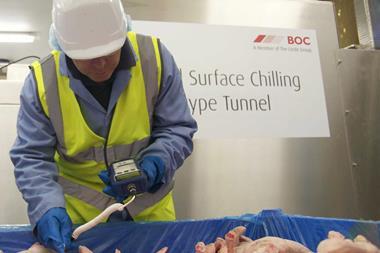The Food Standards Agency (FSA) is exploring the possibility of using controversial procedures such as the immersion of chicken in lactic acid, as part of its battle to eradicate campylobacter.
Speaking yesterday (26 February) after the FSA published the third round of results from its year-long survey into campylobacter in supermarket chicken, FSA director of policy Steve Wearne said the poultry industry “should be able to use the full range of tools at its disposal”.
The treatment of chicken in lactic acid and other chemicals such as chlorine is common in the US, but banned in the European Union. Wearne said the treatment, which is delivered at the end of processing, had “delivered significant results” in the US, and called for a debate into its use in the EU.
“Reducing the worst instances of campylobacter to 10% of supermarket chickens this year is only the start of the story,” he said. “If we meet this target there will be a 30% reduction in instances of food poisoning every year, but we are already thinking about the next step, and are in discussions with the EU, which is also looking at this subject,” Wearne added.
The FSA’s survey into campylobacter in supermarket chicken cost £600,000 said Wearne, who pledged to continue the testing regime indefinitely, and at the same scale of the current survey.
Cumulative results for more than 3,000 fresh chickens tested between February and November 2014 revealed a slight increase in chickens testing positive for some presence of campylobacter, rising to 73% from 70% at the point of the previous survey update.
Some 19% of chickens tested positive for campylobacter with the highest band of contamination (up from 18% in the last results), while 7% of packaging tested positive for the presence of the bug (up from 6%).
While Wearne claimed levels had actually been flat between the second and third tranche of results, he warned that “time was running out” for retailers to reduce contamination levels.
“We need less talking now and more action,” he warned. “We think the court of public opinion will hold those which have not achieved their reduction targets to account.”



















No comments yet